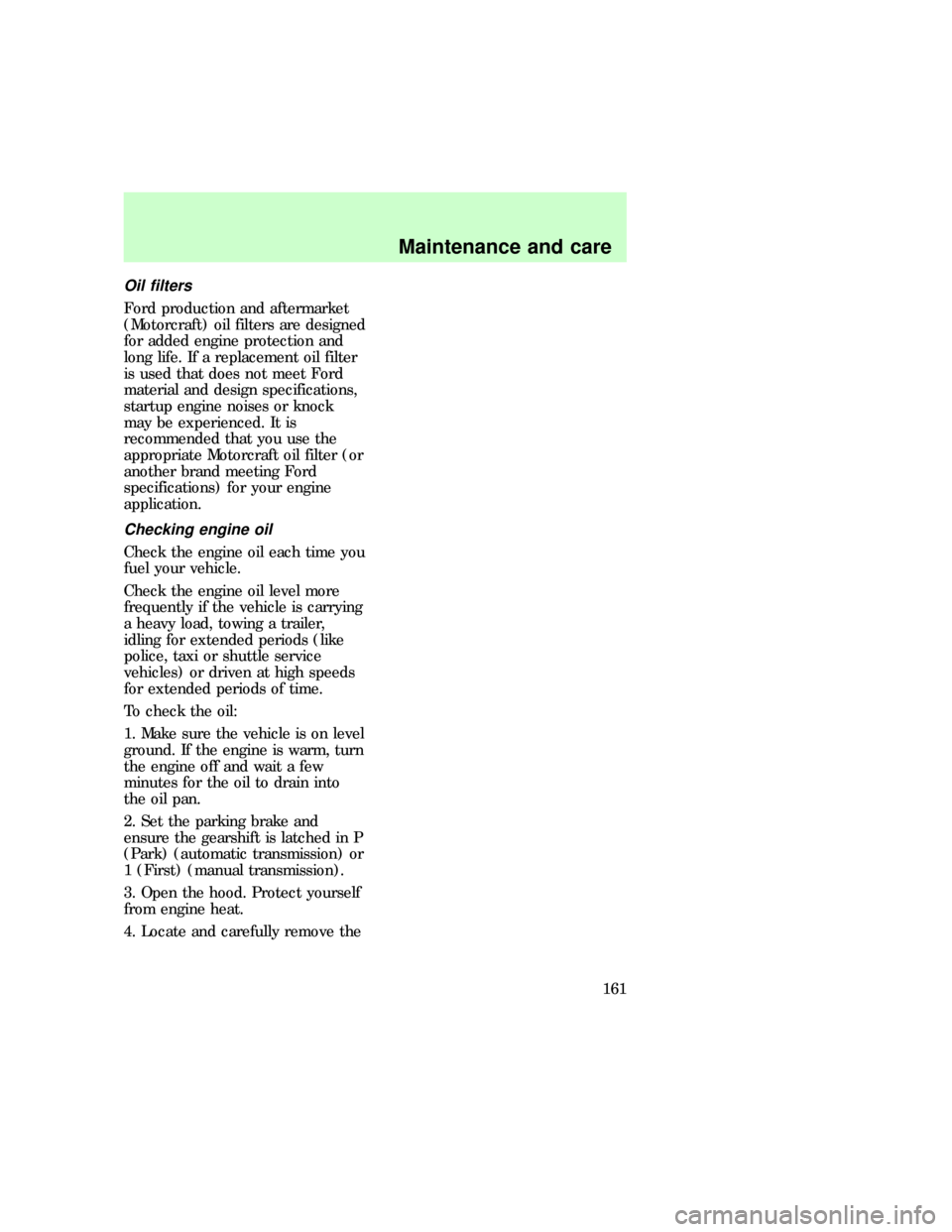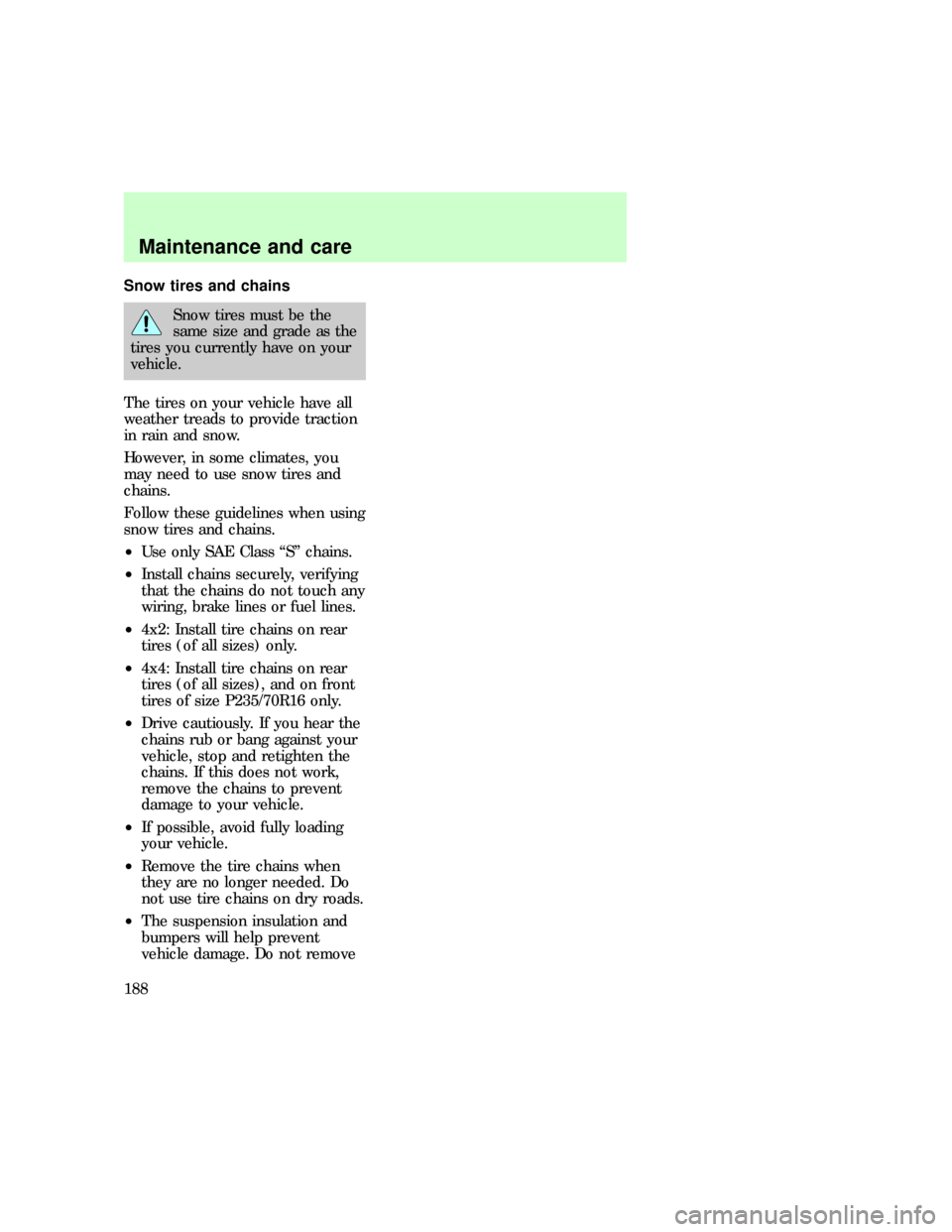Page 157 of 219
4.2L engine
1. Battery
2. Engine oil filler
3. Engine oil dipstick
4. Clutch fluid reservoir (if
equipped)
5. Brake master cylinder
6. Power distribution box
7. Engine coolant recovery
reservoir
8. Radiator cap
9. Air cleaner
10. Power steering fluid reservoir
11. Automatic transmission fluid
dipstick (if equipped)
1
1289761110
2
3
45
Maintenance and care
158
Page 158 of 219
12. Windshield washer fluid
reservoir
4.6/5.4L engine
1. Battery
2. Automatic transmission dipstick
(if equipped)
3. Engine oil filler
4. Engine oil dipstick
5. Clutch fluid reservoir (if
equipped)
6. Brake master cylinder
7. Power distribution box
8. Engine coolant recovery
reservoir
9. Air cleaner
10. Radiator cap
10118129
1245673
f12_4.6L_5.4L_engine
Maintenance and care
159
Page 160 of 219

Oil filters
Ford production and aftermarket
(Motorcraft) oil filters are designed
for added engine protection and
long life. If a replacement oil filter
is used that does not meet Ford
material and design specifications,
startup engine noises or knock
may be experienced. It is
recommended that you use the
appropriate Motorcraft oil filter (or
another brand meeting Ford
specifications) for your engine
application.
Checking engine oil
Check the engine oil each time you
fuel your vehicle.
Check the engine oil level more
frequently if the vehicle is carrying
a heavy load, towing a trailer,
idling for extended periods (like
police, taxi or shuttle service
vehicles) or driven at high speeds
for extended periods of time.
To check the oil:
1. Make sure the vehicle is on level
ground. If the engine is warm, turn
the engine off and wait a few
minutes for the oil to drain into
the oil pan.
2. Set the parking brake and
ensure the gearshift is latched in P
(Park) (automatic transmission) or
1 (First) (manual transmission).
3. Open the hood. Protect yourself
from engine heat.
4. Locate and carefully remove the
f12_checking_oil
Maintenance and care
161
Page 162 of 219
the MAX line, engine damage or
high oil consumption may occur
and some oil must be removed
from the engine by a service
technician.
7. Put the dipstick back in and
ensure it is fully seated.
Adding engine oil
1. Check the engine oil.
2. If the oil level is below the MIN
line, then add engine oil.
3. Remove the yellow oil filler cap.
4. Use a funnel to add oil through
the opening.
Make sure you use a certified
engine oil of the preferred
viscosity.
5. Recheck the oil level. Make sure
that the oil level is not above the
MAX line on the dipstick.
Continuous contact with
usedmotor oil has caused
cancer in laboratory mice.
f12_adding_oil
f12_brake_fluid
Maintenance and care
163
Page 163 of 219
BRAKE FLUID
CHECKING AND ADDING
BRAKE FLUID
Brake fluid should be checked and
refilled as needed at least once
each year:
²Clean the reservoir cap before
removal to prevent dirt or water
from entering the reservoir.
²Visually inspect the fluid level.
²If necessary, add brake fluid
until the level reaches MAX. Do
not fill above this line.
²Use only a DOT 3 brake fluid
certified to meet Ford
specifications. Refer to
Lubricant specificationsin the
Capacities and specifications
chapter.
Brake fluid is toxic.
If you use a brake fluid
that is not DOT 3, you will
cause permanent damage to your
brakes.
MAX
MIN
com_checking-adding_fluid.01
Maintenance and care
164
Page 164 of 219
Do not let the reservoir for
the master cylinder run
dry. This may cause the brakes
to fail.
CHECKING AND ADDING
CLUTCH FLUID (IF EQUIPPED)
During normal operation, the fluid
level in the clutch reservoir will
slowly rise. If the fluid level drops,
maintain the fluid level at the step
in the reservoir.
Use only a DOT 3 brake fluid
designed to meet Ford
specifications. Refer toCapacities
and specifications.
1. Clean the reservoir cap before
removal to prevent dirt and water
from entering the reservoir.
2. Remove cap.
3. Add fluid until the level reaches
the FULL line.
f12_clutch_fluid
f12_washer_fluid
Maintenance and care
165
Page 174 of 219
1. Park the vehicle on a level
surface.
2. Start the engine and move the
gearshift lever through all of the
gear ranges. Allow sufficient time
for each gear to engage.
3. Latch the gearshift lever in P
(Park), set the parking brake and
leave the engine running.
4. Remove the dipstick, wiping it
clean with a clean, dry rag.
5. Install the dipstick.
6. Remove the dipstick and inspect
the fluid level.
²For 4R70W transmissions, the
fluid level should be within the
crosshatched area, or if the
vehicle has not been driven,
DON'T ADD IF IN CROSSHATCHED AREA • CHECK WHEN HOT IDLING IN PARK
Maintenance and care
175
Page 187 of 219

Snow tires and chains
Snow tires must be the
same size and grade as the
tires you currently have on your
vehicle.
The tires on your vehicle have all
weather treads to provide traction
in rain and snow.
However, in some climates, you
may need to use snow tires and
chains.
Follow these guidelines when using
snow tires and chains.
²Use only SAE Class ªSº chains.
²Install chains securely, verifying
that the chains do not touch any
wiring, brake lines or fuel lines.
²4x2: Install tire chains on rear
tires (of all sizes) only.
²4x4: Install tire chains on rear
tires (of all sizes), and on front
tires of size P235/70R16 only.
²Drive cautiously. If you hear the
chains rub or bang against your
vehicle, stop and retighten the
chains. If this does not work,
remove the chains to prevent
damage to your vehicle.
²If possible, avoid fully loading
your vehicle.
²Remove the tire chains when
they are no longer needed. Do
not use tire chains on dry roads.
²The suspension insulation and
bumpers will help prevent
vehicle damage. Do not remove
Maintenance and care
188